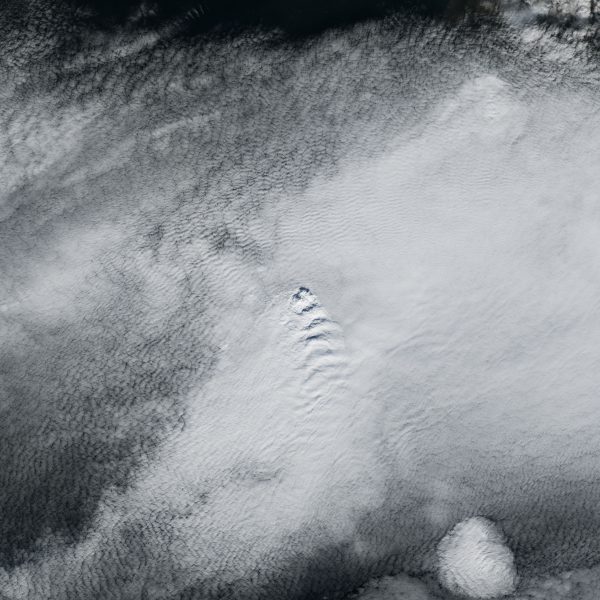The eruption on March 19 at Fagradalsfjall volcano in southwestern Iceland colored the skies brilliant red, illuminating the night with stunning lava flows and with fiery plumes that could be seen from space.
According to the BBC, after weeks of seismic activity in Iceland with more than 50,000 earthquakes recorded, experts warned that lava was moving under the Geldingadalur valley at a superficial depth and could belch lava.
On March 19, an eruption began as lava appeared on the surface area near Fagradalsfjall, one of several shield volcanoes on the peninsula. Shield volcanoes are not very steep and resemble a “warrior’s shield guard resting on the ground.” They are composed solely of basalt lava, which is very fluid upon eruption.
News reports announced that a river of lava could be seen from the country’s capital city of Reykjavik, situated 30 kilometers away. The event was bright and large enough for NASA and NOAA satellites to observe. Hot lava streamed from a fissure that was originally 500 to 700 meters (1,600 to 2,300 feet) long. After accumulating, the continuous output broke down mounds of cooled lava called spatter or cinder cones.
This was the first historic eruption of the volcano in the Reykjanes Peninsula in nearly 800 years, the Associated Press reported.
Success
You are now signed up for our newsletter
Success
Check your email to complete sign up
No injuries from the lava or danger from volcanic ash or gasses have been reported so far. However, according to the Iceland Meteorological office, experts are monitoring the progress of the volcano’s activity and share forecast reports.
According to an IMO news report, as the eruption in Fagradalsfjall continues through one main crater, the active crater is the fifth fissure opening that opened in the area on the 13th of April. Since April 27, the lava from the cinder cone was seen spewing hundreds of meters into the air. In early May, the eruption began oscillating, reaching 13 cubic meters per second.
The fiery plume even produced its own unique pattern in the atmosphere in the form of wave clouds observed by NASA. In early May, the eruption began oscillating, starting and stopping alternatively.



Almost 30 million cubic meters of lava have spilled since the start of the eruption. In late March, according to a volcano activity update, the lava flow was apparently so spectacular that residents of the town of Grindavík decided to call the lava field “Fagradalshraun,” meaning Beautiful Lava Valley, reported Reykjavík Newscast.
In a quick attempt to stop the lava from entering the Natthagi valley, an artificial dam was built. By now, however, it has entered the valley, which leads towards the southern Ring Road. The lava created a stunning lava fall to many onlooker’s awe and delight as it descended the northern precipice. It then formed a new flow in the valley below, following and covering the hiking path that leads from the parking area northwards to the eruption zone.
Fissure Vent Number Five is still producing lava flows. During the past two weeks, at intervals of around 7 to 10 minutes, pulsating lava fountains of 400-500 m in height have continued to fall into the Meradalir valley since April 24.
According to the formation of lava flows, the eruption shows no signs of ceasing, reported Icelandic Met Office group leader Kristín Jónsdóttir. The Icelandic Met Office volcano activity update on May 12 stated that the eruption has become more volatile due to changes at the magma chamber at depths between 15-20 km.
Cause for heightened activity in Iceland’s erupting volcano unclear
Experts are now interested in discovering what caused the change in eruptive behavior and its mean concerning near-future eruptions in Iceland. For weeks the eruptions were stable with constant steady lava flow and mild spattering at several vents. It is pulsating, from relatively quiet flow at a low rate to very strong lava fountaining from a single vent.
In an article on Icelandic National Broadcasting Service’s website (RUV), Experts said, “We’re trying to understand the sore throat it appears to have got. I guess not only is there more gas in there, but there are also either bottlenecks or blockages down there and probably more water in the magma.”
According to Þorvaldur Þórðarson, professor of volcanology, the eruption has entered a phase of being more volatile. Still, it is not clear whether this suggests it is in decline or expansion.
“But what is happening is that the gas that is being released from the magma, it is not flowing out of the magma as it has done so far, but it seems to come with certain pulses into the system and then tear itself up. There is something that is delaying the gas release for a certain period of time, until pressure builds up and the gas-rich magma manages to erupt to the surface in [the] form of large jets,” he said.







